Cuba: Timeline of a revolution
A look at Havana’s troubled relations with the US.
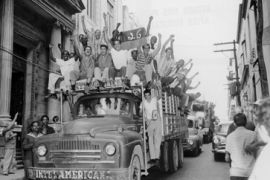
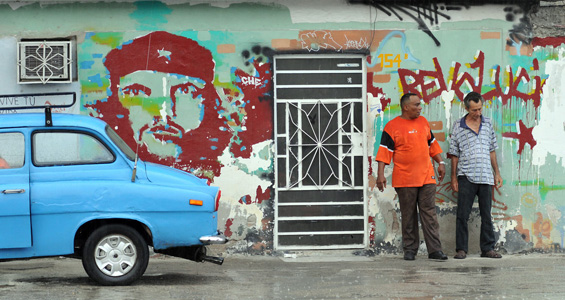 |
| Cuba’s defiance of the US has helped to make Fidel Castro and Che Guevara folk heroes [EPA] |
Washington has played an integral role in the internal politics of Cuba since US military forces defeated Spain in the Spanish-American war.
Many of the island’s revolutionaries and dissidents viewed Havana’s close ties and what they called subservience to Washington as running counter to national interests and aspirations.
They pointed to the fact that US firms controlled majority stakes in Cuba’s mineral wealth, its utility system and influence in the sugar trade.
While the Cuban Revolution did not take place until 1959, it was events which preceded it that fuelled the popular disenfranchisement that gave rise to rebel figures such as Fidel Castro.
Below is a brief timeline of Cuba’s revolution in the making.
1898: The US takes control of Cuba after Spain is defeated in the Spanish-American War and cedes all claims to the island.
1902: Although Cuba declares independence it remains a US protectorate.
1905: US companies buy millions of dollars worth of Cuban land.
1905-1929: The US military intervenes several times to put down coups, uprisings and facilitate elections.
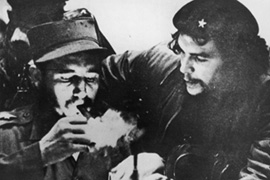 |
| Che Guevara joins the rebels after Fidel Castro’s release from prison [GALLO/GETTY] |
1925: The Cuban Communist party is established.
1929: Following the stock market crash, the price of sugar, a main export, falls. Economic strife fuels revolutionary fervour.
1933: A revolutionary junta led by military officer Fulgencio Batista seizes control of Cuba.
1934: The US ambassador to Cuba reports that the new government is very unpopular “with all the better classes” and supported by the military only.
1942: The Communist Party is legalised.
1944: Batista steps down and a civilian government takes control.
1945: Cuba joins the United Nations.
1948: Fidel Castro, a young student with revolutionary zeal, participates in an uprising in Colombia.
1952: Batista, who had been elected to the Cuban senate, seizes power, suspends the 1940 constitution and cancels elections. The US recognises his rule.
1953
July 26: Castro leads a ragtag group of 160 rebels in an attack against the Moncada military base in Santiago de Cuba, Cuba’s second-largest city. Most of his followers are killed.
October 6: The 26 survivors of the rebel attack are found guilty and imprisoned. Castro is given 15 years.
October 31: The Cuban Communist Party is outlawed.
1954: Castro’s ‘History will Absolve Me’ speech during his trial becomes a rebel manifesto and is spread throughout the country.
1955
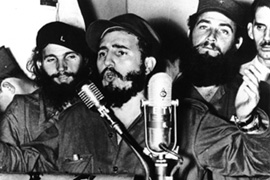 |
| Fidel Castro during an address in Cuba after Batista was forced to flee [GALLO/GETTY] |
February 25: Batista becomes president following elections.
April: The CIA sets up the Bureau for the Repression of Communist Activities in Cuba.
May 15: Castro is given amnesty and released from prison. He then leaves Cuba. Che Guevara joins his cause.
1956: Castro launches a revolutionary war from outside Cuba. He later arrives in the Sierra Maestra mountains and wages a guerrilla campaign against the Batista government.
1957: With a small supply of weapons, Castro’s followers begin to attack oil facilities, government buildings, and radio stations. The government increases repression and arrests and/or kills those suspected of colluding with the rebels. US press reports indicate an American-trained force will hunt down Castro. Senior Castro allies are killed in Havana.
1958: The Cuban army launches a major offensive against Castro in the Sierra Maestra mountains. With the rebels winning major military confrontations, they publish dissident newspapers and set up agrarian reform councils. The US, which had previously supplied Batista with millions of dollars in arms, begins to withdraw support and tries to pressure him to leave for Florida. He rejects the offer.
1959
January 1: Rebel forces led by Guevara seize control of the capital. Batista flees.
January 7: With 9,000 fighters in tow, Castro enters Havana and the US recognises the new Cuban government. Scores of police officers and former Batista henchmen are tried and executed. Castro becomes prime minister and launches a nationlisation drive which causes an uproar in Washington.
April: Castro visits the US.
June: Guevara opens talks with the Soviets during a visit to Egypt.
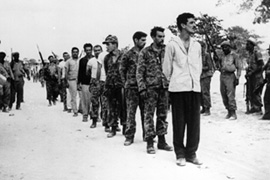 |
| Captured Cubans exiles who attempted the Bay of Pigs invasion [GALLO/GETTY] |
October: Raul Castro becomes minister of the armed forces. The US begins to impose sanctions and an embargo on Cuba. The CIA is rumoured to be creating a counter-revolutionary force of Cuban dissidents.
1960: Cuba and the USSR formalise ties; Havana begins to receive Soviet aid including oil and arms. Cuban dissidents in Florida begin broadcasting. All US assets are nationalised. Newspapers begin speculating that an invasion of Cuba is imminent.
1961: All diplomatic ties with the US are cut. Bombs explode in commercial districts in Havana.
April 17: Cuban dissidents, backed by the CIA, invade Cuba at Playa Giron. The invasion goes down in history as the Bay of Pigs fiasco when the dissident force is overwhelmingly defeated.
April 19: Castro responds to the US role in the invasion by declaring Cuba a socialist country and moving even closer into the Soviet sphere. This culminates in the Cuban Missile Crisis when Castro begins to host Soviet Nuclear missiles fearing a larger US invasion.